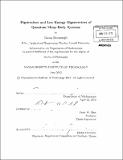| dc.contributor.advisor | Peter W. Shor. | en_US |
| dc.contributor.author | Movassagh, Ramis | en_US |
| dc.contributor.other | Massachusetts Institute of Technology. Dept. of Mathematics. | en_US |
| dc.date.accessioned | 2012-09-27T15:26:18Z | |
| dc.date.available | 2012-09-27T15:26:18Z | |
| dc.date.copyright | 2012 | en_US |
| dc.date.issued | 2012 | en_US |
| dc.identifier.uri | http://hdl.handle.net/1721.1/73370 | |
| dc.description | Thesis (Ph. D.)--Massachusetts Institute of Technology, Dept. of Mathematics, 2012. | en_US |
| dc.description | Cataloged from PDF version of thesis. | en_US |
| dc.description | Includes bibliographical references (p. 211-221). | en_US |
| dc.description.abstract | I first give an overview of the thesis and Matrix Product States (MPS) representation of quantum spin systems on a line with an improvement on the notation. The rest of this thesis is divided into two parts. The first part is devoted to eigenvalues of quantum many-body systems (QMBS). I introduce Isotropic Entanglement (IE) and show that the distribution of QMBS with generic interactions can be accurately obtained using IE. Next, I discuss the eigenvalue distribution of one particle hopping random Schrbdinger operator in one dimension from free probability theory in context of the Anderson model. The second part is devoted to ground states and gap of QMBS. I first give the necessary background on frustration free Hamiltonians, real and imaginary time evolution of quantum spin systems on a line within MPS representation and the numerical implementation. I then prove the degeneracy and unfrustration condition for quantum spin chains with generic local interactions. Following this, I summarize my efforts in proving lower bounds for the entanglement of the ground states, which includes partial results, with the hope that it will inspire future work resulting in solving the conjecture given. Next I discuss two interesting measure zero examples where the Hamiltonians are carefully constructed to give unique ground states with high entanglement. This includes exact calculations of Schmidt numbers, entanglement entropies and a novel technique for calculating the gap. The last chapter elaborates on one of the measure zero examples (i.e., d = 3) which is the first example of a Frustration Free translation-invariant spin-i chain that has a unique highly entangled ground state and exhibits signatures of a critical behavior. | en_US |
| dc.description.statementofresponsibility | by Ramis Movassagh. | en_US |
| dc.format.extent | 221 p. | en_US |
| dc.language.iso | eng | en_US |
| dc.publisher | Massachusetts Institute of Technology | en_US |
| dc.rights | M.I.T. theses are protected by
copyright. They may be viewed from this source for any purpose, but
reproduction or distribution in any format is prohibited without written
permission. See provided URL for inquiries about permission. | en_US |
| dc.rights.uri | http://dspace.mit.edu/handle/1721.1/7582 | en_US |
| dc.subject | Mathematics. | en_US |
| dc.title | Eigenvalues and low energy eigenvectors of quantum many-body systems | en_US |
| dc.type | Thesis | en_US |
| dc.description.degree | Ph.D. | en_US |
| dc.contributor.department | Massachusetts Institute of Technology. Department of Mathematics | |
| dc.identifier.oclc | 809680332 | en_US |
